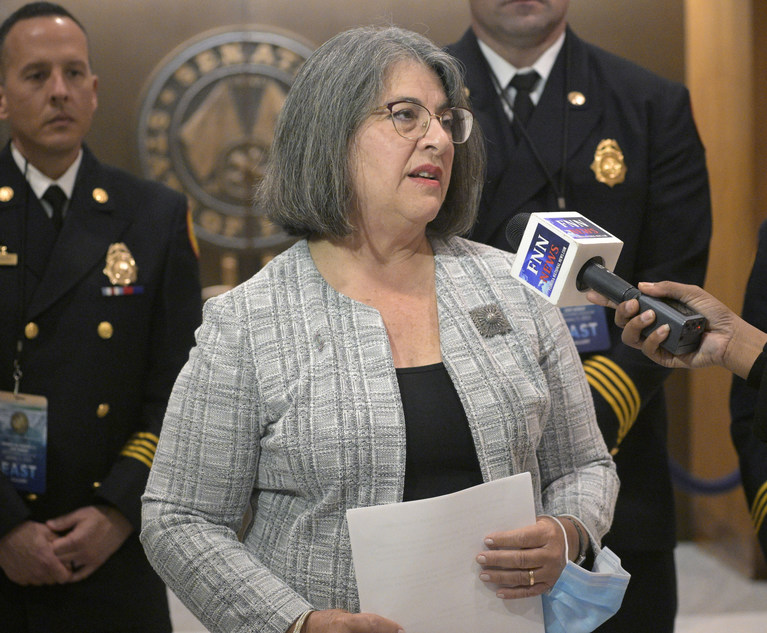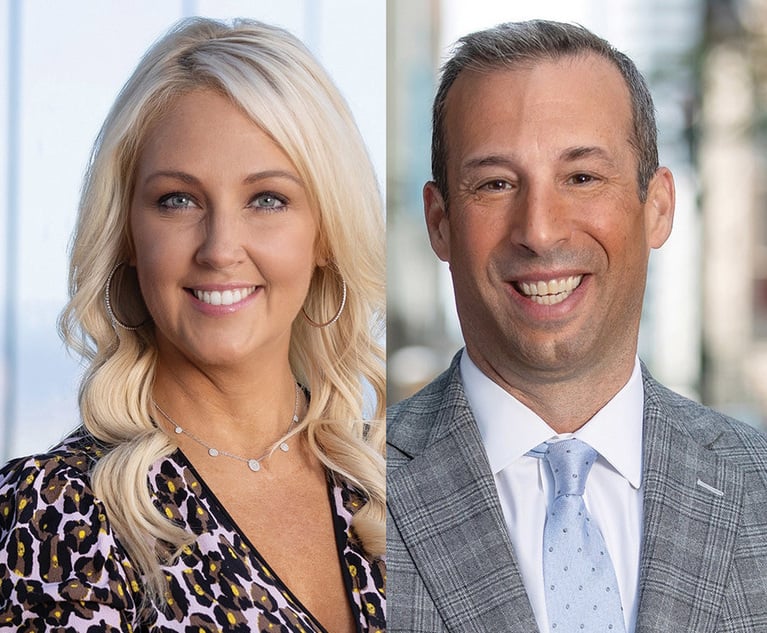 Miami-Dade County Mayor Daniella Levine Cava. Photo: Phelan M. Ebenhack/AP
Miami-Dade County Mayor Daniella Levine Cava. Photo: Phelan M. Ebenhack/AP Miami-Dade County Begins Removing Polluting Septic Tanks
"This is a big step toward mitigating the effect of climate change on our county," Mayor Daniella Levine Cava said.
January 31, 2022 at 12:44 PM
5 minute read
Miami-Dade County's plan to address one of the biggest sources of pollution in Biscayne Bay — and one of the grossest consequences of rising seas — kicked off with a ceremonial shovelful of dirt tossed in the air just north of Miami's Shorecrest neighborhood.
"This is the launch to a major overhaul," Mayor Daniella Levine Cava told the crowd. "This is a big step toward mitigating the effect of climate change on our county."
Thousands of homes in Miami-Dade flush their toilets and showers into underground concrete boxes that filter that wastewater down into the dirt and aquifer below. But as sea levels rise, those septic tanks don't have room to drain. They send that dirty water into Biscayne Bay, sometimes causing fish kills, or in the worst cases, overflow into yards and homes.
Miami-Dade has an estimated 120,000 of those time bombs buried all over the coastal county, with a majority in north Dade. About 9,000 of them are already at risk of failing or not working as well. With just a foot or so of sea rise, expected by about 2040, that number swells to 13,500.
Fixing all of them is a multibillion-dollar affair. One county estimate suggests it could be north of $3 billion, an undercount that doesn't include commercial properties or the portion of the cost borne by homeowners.
County officials say they plan to spend more than $230 million to help convert a little over 13,000 of the 120,000 remaining tanks in the next five years. The county's strategy, released in 2020, tackles the most vulnerable septic tanks first, the 9,000 that are likely already poisoning the bay.
Starting in February, Miami-Dade plans to spend $1 million over four months building new pipes and pumps to connect 40 homes along Northeast 87th Street to county sewer lines. That includes everything right up to the property line. From there, it's the homeowner's responsibility to pay for the new plumbing and remove the old septic tank.
That can be costly, an estimated $10,000 per home.
To help some of the residents who can't swing that, Miami-Dade got a $4.4 million grant from the Florida Department of Environmental Protection, out of the $10 million the state set aside to help Biscayne Bay, to help cover costs for the lowest-income residents. Some of that grant money will also be given to property owners with septic tanks outside of the updated areas, so they can inspect and maintain their systems.
"Price will not be a barrier. We will connect to protect in Little River," Levine Cava said. "Each and every property, one by one, is going to be addressed."
The news that Miami-Dade is finally breaking ground on an issue that's been looming for 70 years is a relief to environmentalists like Aaron Stauber, a board member of Miami Waterkeeper who's done significant research into the issue.
"It's excellent," he said. "Anything like that, especially when it's directed in a focused way, especially with regard to where the biggest issues are, is very heartening."
Phase two of the strategy focuses on Larchmont Gardens, a community just south of Little River, where the county will spend about $18 million to enable another 300 homes to connect to sewer. That is scheduled to begin in March 2023 and take until March 2025.
Next up, the county plans to set its sights on the Ojus neighborhood in north Dade. It has $10 million dedicated to building out the system so more properties can convert from septic to sewer.
In addition to those individual projects, Miami-Dade has $90 million dollars set aside by the county commission to build the equipment necessary to connect 12,000 septic tanks, the ones that are already close to existing county sewer lines. And that's on top of the $126 million the county has earmarked to convert 1,000 commercial septic tanks.
Roy Coley, head of the county's water and sewer department, estimated Miami-Dade could address all of those nearby septic tanks in the next five years. But the remaining hundred thousand septic tanks will be more difficult — and far more expensive — to tackle.
"The timeframe for expanding sewer to the 9,000 properties most vulnerable to rising groundwater is 5-10 years. It is important to note that this is assuming funding is identified for this purpose. The expansion of the sewer system is currently unfunded," Coley said in an email.
And despite the new burst of funding and attention to the long-standing issue of septic tanks, the county continues to not only cut property owners slack on connecting to sewer when they are legally mandated to, but also to permit new septic tanks to be built.
The county says it's because of the expense of connecting, something most Miami-Dade residents cannot afford, and because in some places where new homes are being built there's no sewer to tap into.
"I think that's misguided," said Stauber, with Waterkeeper. He would like to see the county pushing developers harder, either by pointing them toward developing in areas that already have sewer or by fronting the cost of installing new sewer lines themselves.
Part of the county's septic to sewer conversion strategy included pursuing low-cost financing options to help homeowners afford to connect. Coley said the option is still on the table but details haven't been ironed out yet.
"Everything is still being discussed," he said.
Alex Harris reports for the Miami Herald.
NOT FOR REPRINT
© 2025 ALM Global, LLC, All Rights Reserved. Request academic re-use from www.copyright.com. All other uses, submit a request to [email protected]. For more information visit Asset & Logo Licensing.
You Might Like
View All


Miami Firm Reaches $1.9M Settlement for Protester's Injuries, Pursues Class Action for Others
Trending Stories
- 1'It's Not Going to Be Pretty': PayPal, Capital One Face Novel Class Actions Over 'Poaching' Commissions Owed Influencers
- 211th Circuit Rejects Trump's Emergency Request as DOJ Prepares to Release Special Counsel's Final Report
- 3Supreme Court Takes Up Challenge to ACA Task Force
- 4'Tragedy of Unspeakable Proportions:' Could Edison, DWP, Face Lawsuits Over LA Wildfires?
- 5Meta Pulls Plug on DEI Programs
Who Got The Work
Michael G. Bongiorno, Andrew Scott Dulberg and Elizabeth E. Driscoll from Wilmer Cutler Pickering Hale and Dorr have stepped in to represent Symbotic Inc., an A.I.-enabled technology platform that focuses on increasing supply chain efficiency, and other defendants in a pending shareholder derivative lawsuit. The case, filed Oct. 2 in Massachusetts District Court by the Brown Law Firm on behalf of Stephen Austen, accuses certain officers and directors of misleading investors in regard to Symbotic's potential for margin growth by failing to disclose that the company was not equipped to timely deploy its systems or manage expenses through project delays. The case, assigned to U.S. District Judge Nathaniel M. Gorton, is 1:24-cv-12522, Austen v. Cohen et al.
Who Got The Work
Edmund Polubinski and Marie Killmond of Davis Polk & Wardwell have entered appearances for data platform software development company MongoDB and other defendants in a pending shareholder derivative lawsuit. The action, filed Oct. 7 in New York Southern District Court by the Brown Law Firm, accuses the company's directors and/or officers of falsely expressing confidence in the company’s restructuring of its sales incentive plan and downplaying the severity of decreases in its upfront commitments. The case is 1:24-cv-07594, Roy v. Ittycheria et al.
Who Got The Work
Amy O. Bruchs and Kurt F. Ellison of Michael Best & Friedrich have entered appearances for Epic Systems Corp. in a pending employment discrimination lawsuit. The suit was filed Sept. 7 in Wisconsin Western District Court by Levine Eisberner LLC and Siri & Glimstad on behalf of a project manager who claims that he was wrongfully terminated after applying for a religious exemption to the defendant's COVID-19 vaccine mandate. The case, assigned to U.S. Magistrate Judge Anita Marie Boor, is 3:24-cv-00630, Secker, Nathan v. Epic Systems Corporation.
Who Got The Work
David X. Sullivan, Thomas J. Finn and Gregory A. Hall from McCarter & English have entered appearances for Sunrun Installation Services in a pending civil rights lawsuit. The complaint was filed Sept. 4 in Connecticut District Court by attorney Robert M. Berke on behalf of former employee George Edward Steins, who was arrested and charged with employing an unregistered home improvement salesperson. The complaint alleges that had Sunrun informed the Connecticut Department of Consumer Protection that the plaintiff's employment had ended in 2017 and that he no longer held Sunrun's home improvement contractor license, he would not have been hit with charges, which were dismissed in May 2024. The case, assigned to U.S. District Judge Jeffrey A. Meyer, is 3:24-cv-01423, Steins v. Sunrun, Inc. et al.
Who Got The Work
Greenberg Traurig shareholder Joshua L. Raskin has entered an appearance for boohoo.com UK Ltd. in a pending patent infringement lawsuit. The suit, filed Sept. 3 in Texas Eastern District Court by Rozier Hardt McDonough on behalf of Alto Dynamics, asserts five patents related to an online shopping platform. The case, assigned to U.S. District Judge Rodney Gilstrap, is 2:24-cv-00719, Alto Dynamics, LLC v. boohoo.com UK Limited.
Featured Firms
Law Offices of Gary Martin Hays & Associates, P.C.
(470) 294-1674
Law Offices of Mark E. Salomone
(857) 444-6468
Smith & Hassler
(713) 739-1250







